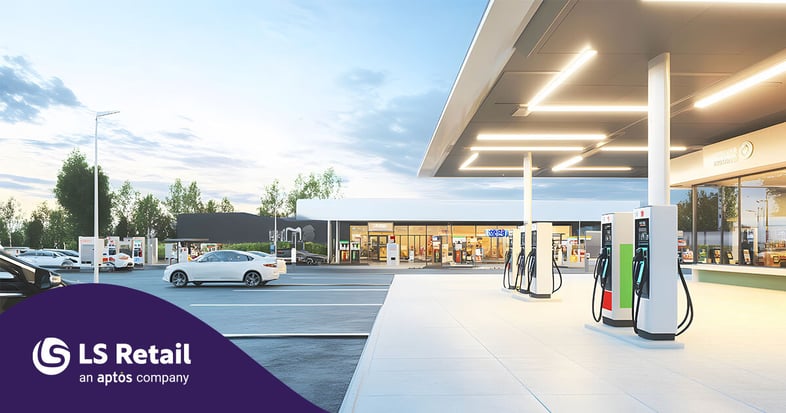4 trends that are changing the gas station industry

Fuel and petrol stations are becoming more than just pit stops for pumping gas or picking up a quick snack on the road.
Much like other areas of retail, the forecourt industry is evolving into an entire experience catering to the needs of everyday customers – from grocery essentials and quick-service meals to parcel pickup points and entertainment facilities. And it’s not just the introduction of EV charging and alternative fuel methods that are changing the game, but consumer habits, too.
According to research from Deloitte, 80% of consumers prefer spending on experiences over goods. To keep up, leading brands in developed markets are expanding their offerings and rethinking the role of gas stations as a destination for convenience rather than simply fuel.
Is your forecourt business prepared for the future? Here are four of the biggest trends that are changing the gas station industry today.
1. Expanding further into the grocery sector
Today, there's a surge of fuel retailers upgrading their convenience store formats to serve consumers' grocery needs. Instead of just simple snacks and sodas, they're adding fresh produce, pantry essentials, meal kits, and even ready-to-eat meals. But why the shift?
Consumers are more and more strapped for time, and they're looking for fast, accessible alternatives to traditional supermarkets. The National Association of Convenience Stores (NACS) reports that over 83% of convenience stores in the U.S. sell prepared food, and foodservice now accounts for more than 35% of in-store sales, a number that continues to climb each year. What’s more, nearly one in four consumers say they would shop more frequently at a c-store if it offered better grocery selections.
For the gas station industry, this marks a powerful shift. Fuel margins are shrinking, but food margins remain strong. For example, U.S. convenience store chains like Sheetz and Casey’s have been expanding their fresh food programs, with Casey’s reporting over $1.3 billion in prepared food and dispensed beverage sales in 2024 alone. With fewer large weekly grocery trips and more frequent “fill-in” purchases, convenience stores can help fuel retailers increase revenue as well as retention.
2. More diverse payment methods
Forecourt businesses are finding ways introduce faster checkout options as customers demand their experience to embody convenience.
A recent report by Mastercard found that 67% of European consumers now prefer contactless payments for everyday purchases, including fuel. In response, forecourt operators are adopting solutions that go far beyond traditional card readers, such as in-car payments, which works like a digital wallet on wheels, and integrated mobile apps for browsing, payments, and loyalty.
With the help of NFC (near-field communication) technology, customers can simply scan a code, tap their phone, or instant pay at the pump or for services. In markets like Europe and the U.K., where mobile wallet adoption is particularly high, these technologies are helping to make the payment process nearly invisible.
3. Data-fueled loyalty and promotions
Fuel and convenience retailers are no longer relying solely on generic discounts or punch-card loyalty. Instead, they’re using AI-driven platforms to analyze purchase history, visit frequency, and even time-of-day habits to tailor offers that feel relevant and timely.
A recent Capgemini report found that 80% of European consumers are more likely to engage with brands that offer personalized experiences — something forecourt operators are now delivering through apps, loyalty platforms, and targeted campaigns.. In Singapore, for example, the Shell GO+ rewards program leverages purchase history and vehicle data to offer personalized rewards, discounts on premium fuels, and bundled food deals.
At the same time, AI is working behind the scenes to identify purchasing patterns and help fuel retailers prepare better for demand. Using predictive analytics, retailers can determine the best time to launch campaigns, what products to bundle, and how to segment their audiences most effectively. This kind of precision makes it easier to understand what customers want, and when, to keep them coming back.
4. Becoming a multi-service center
As the transition to electric vehicles accelerates, fuel retailers are rethinking what a gas station can —and should — offer. With EV charging sessions often taking 20 to 40 minutes, stations can no longer rely on quick fuel stops alone. Instead, they’re evolving into full-fledged service centers, designed to give customers more reasons to visit, even when they’re not refueling.
To make the most of that dwell time, stations are adding a range of new services: delivery lockers for parcels, express car washes, and even fitness centers are becoming more common throughout the world. This shift is pushing fuel retailers to rethink their entire business model, moving away from reliance on fuel sales — which have been steadily declining — and toward foodservice, retail, and lifestyle offerings that drive long-term growth.
Ultimately, this evolution isn’t just about adapting to new technology, but about becoming a one stop destination that fits into customers’ daily lives, and ultimately stay competitive for the long-term.
The business of tomorrow in the trends of today
Changes to the gas station industry are already in motion, and it’s time for your business to adapt.
Reach out to our team to find out more about how are modular software solutions for forecourt, retail, food service, and more can help you meet tomorrow's demands.
